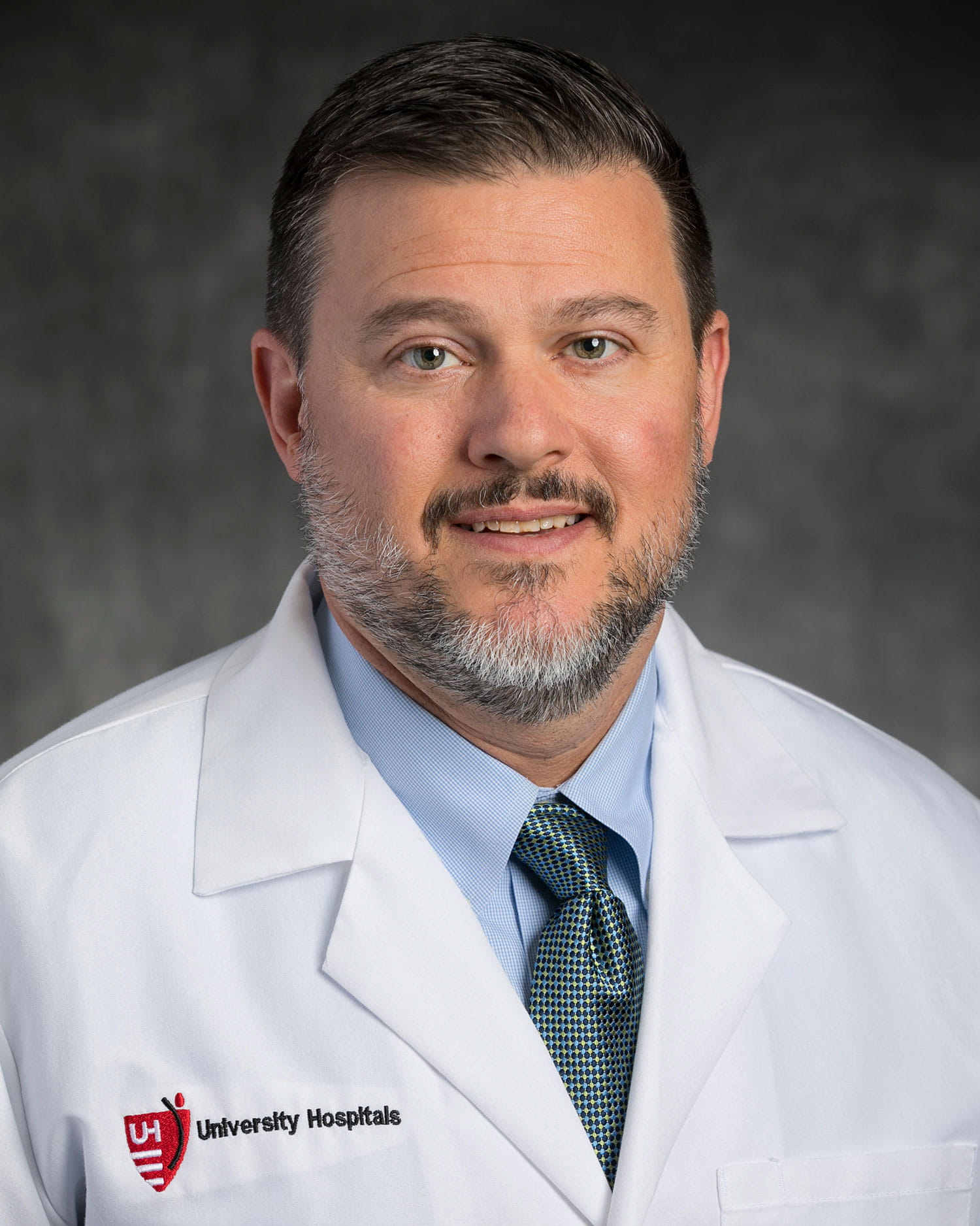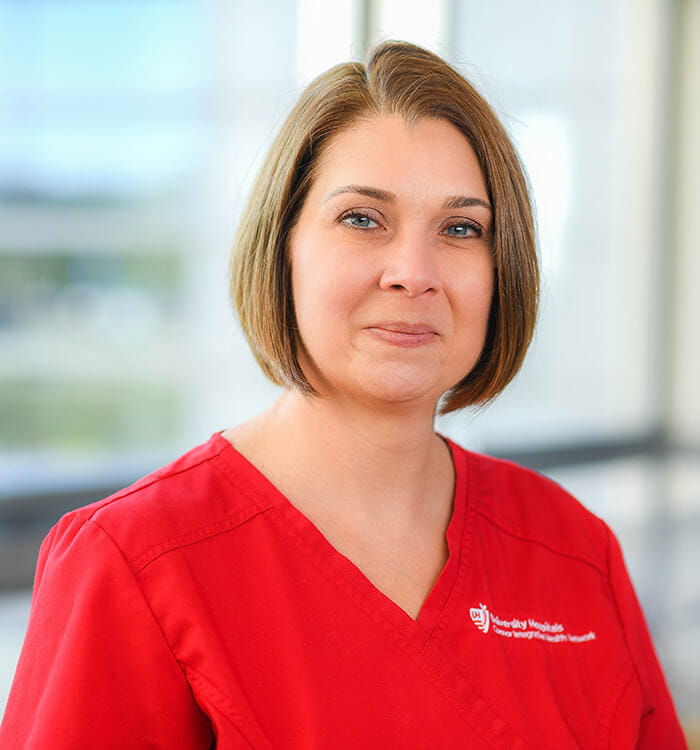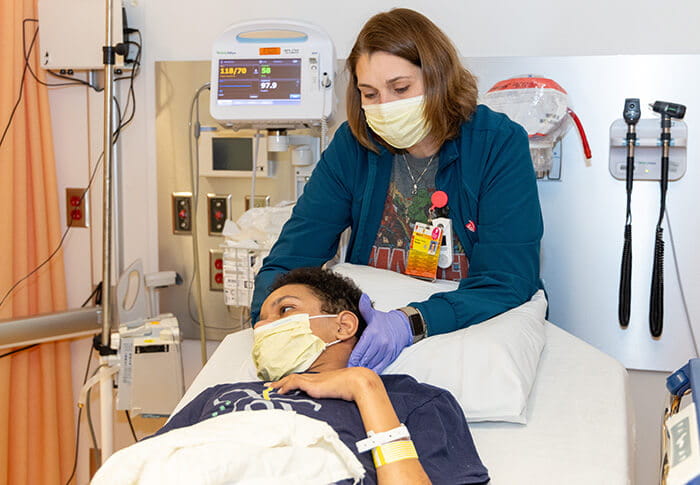UH Rainbow Babies & Children’s Hospital a National Leader in Massage Therapy for Pediatric Cancer and Sickle Cell Disease Patients
June 18, 2023

Large new published study - one of the first of its kind - documents the benefits
Innovations in Pediatrics | Summer 2023
Massage therapy provided by a certified pediatric massage therapist (CPMT) can lessen pain, stress and anxiety among children and teens hospitalized for cancer or sickle cell disease (SCD). That’s the conclusion of a new study from University Hospitals Connor Whole Health and UH Rainbow Babies & Children’s Hospital, which offers one of the nation’s only fully integrated pediatric massage therapy programs for these patients. The study, published in the journal Pediatric Blood & Cancer, involved 3,015 massage therapy sessions for 243 patients over more than two years, making it one of the largest research efforts of its kind on the subject.
 David W. Miller, MD, LAc
David W. Miller, MD, LAc Mandy Bartolovich, CPMT, LMT, MA
Mandy Bartolovich, CPMT, LMT, MA“There were patient-reported outcomes of levels of pain, anxiety and stress before and after treatment, and we saw a statistically significant and overall significant decrease in all three of those measures utilizing massage as the intervention,” says David W. Miller, MD, LAc, Medical Director of Pediatric Integrative Medicine at UH Connor Whole Health and co-senior author of the study.
Research Provides Guidance
Dr. Miller says he and his UH Rainbow colleagues were motivated to conduct the study by a relative lack of research on non-pharmacological interventions that are effective for pediatric patients with cancer or SCD – despite government mandates that hospitals provide such interventions.
“There's very little out there to tell hospitals,” he says. “We're mandated to provide these non-pharmacologic options, but there's no guidelines on what to provide, and there's virtually no evidence base for it. Specifically, there's very little out there describing the impact of massage in this population. Because we have this massage therapy program here at UH Connor Whole Health and UH Rainbow, we wanted to measure our impact and determine whether it was meaningful. It turned out it was meaningful, which is great. The work demonstrates that massage therapy should be integral to clinical services in this domain. The other thing we really wanted to explore was safety -- can this intervention be delivered safely and effectively even in these vulnerable populations, and will patients accept it and want it? And, it turns out, they do want it, it was effective, and no adverse effects were seen.”
Study Methods
The pediatric massage therapy sessions in the current study spanned from October 24, 2019 to December 29, 2021 at UH Rainbow. Before and after each session, the dedicated CPMT asked each patient to rate their pain, stress and anxiety on a 10-point scale. As a matter of course, these responses are given verbally by the patient, not the parent or caregiver, and then are noted in the electronic health record.
In addition, the study team gathered and analyzed data on patient demographics, insurance coverage, clinical characteristics including ICD-10 codes, discharge location, length of stay and pre-treatment chief complaint. For each massage therapy session, the starting and ending time, body regions addressed, massage therapy technique used, patient position, precautions taken and massage pressure used were also noted.
Impact for Patients
Study results show that massage therapy provided by a CPMT is indeed meaningful for pediatric patients with cancer or SCD.
“Both the HemOnc and SCD groups reported statistically significant reductions in pain, stress and anxiety, and the majority reported relief meeting clinically significant thresholds,” Dr. Miller says. “The adjusted mean pain change within the SCD group of 1.87 is significant, given the substantial pain burden within this population.”
For CPMT Mandy Bartolovich, CPMT, LMT, MA, who provided massage therapy for every patient in the study, these results are not at all surprising.
 Mandy Bartolovich, LMT during massage therapy session with UH Rainbow patient.
Mandy Bartolovich, LMT during massage therapy session with UH Rainbow patient.“I wasn't surprised because I see the impact of massage with the kids every day,” she says. “If anything, I was surprised by the number of kids that took advantage of the service within the two years of this study. During the height of COVID, I was asked to come back to the hospital early by staff, families and patients. The patients stated the massages were helping with their anxiety, which in turn helped with their pain.”
“I was very happy to see the real numbers, to be able to really quantify it,” adds Dr. Miller. “In order to make an impact and promote change, you need to have the data to back up what you're doing. This study provides some really compelling data to advocate for this kind of care. We fully acknowledge that more research is indicated, but our results are compelling enough that programs should be started and studied, rather than waiting for more research to justify starting a program. Kids need non-pharmacologic strategies now.”
Recommended Steps
For children’s hospitals that are interested in providing massage therapy to their patients with cancer or SCD, Bartolovich says specific training for the massage therapist is essential. Plus, Dr. Miller adds, the massage therapist must be fully integrated with the care team.
“Unlike care models that contract with outside massage therapy services, the model presented in this study involves close collaboration with the medical team to provide coordinated care for symptom management and procedural support,” he says. “There was some skepticism and worry when the program started, but over time with experience, people have come to trust the care given. Mandy rounds with the team and reads the charts and knows the medical history of the kids that she's working on. We really take that extra time to be part of the care delivery team, not just an adjunct. That makes a huge difference.”
For more information about this study or the massage therapy program at UH Rainbow, please email Peds.Innovations@UHhospitals.org.
Contributing Experts:
David W. Miller, MD, LAc
Medical Director of Pediatric Integrative Medicine
UH Connor Whole Health
Mandy Bartolovich, CPMT, LMT, MA
Certified Pediatric Massage Therapist
University Hospitals


